Help me to create an ideal area for Gunnera
I have a hot dry yard, but I want to try growing Gunnera. I've read all the other threads about this plant and I've read the threads about creating a bog. Can some of these ideas be combined to successfully grow this plant?
My idea has been to create a smallish bog area, with a large mound on top for planting. I'd dig a 3'x3' area down to about 24", place a used tarp into the hole and fill with manure/dirt. Then I'll create a mound above this for planting the Gunnera. How's this sound? Do you think I'll kill it with wet roots? I've read where they won't live IN a bog, but near one. Think this would be far enough away?
Anyone got any better ideas to help me out?
far
Comments (22)
glenik
19 years agoI have planted a couple of these Gunnera and of course have my own opinions and please take them as that.... my opinions only.
If you can they do prefer shade from the midday sun if possible, they of course will do ok in full sun with lots of water but this can be more of a challenge due to the high sun location. Shade will help both you and the plant in keeping moist conditions at all times.
Under the plant I first dug in somewhat of a liner in the shape of a donut(that is a circular basin with a hole in the middle of about 2ft in diameter. My theory is that it does not sit in water but has a regular moist ring around it at all times. I must add that I have run an old hose underground to the location that comes off a splitter on my outside tap which I use for the watering every morning and evening if it gets very hot, otherwise once in the morning is alright.
By using this method the plant can be placed just about anywhere. If you put your bog in full sun yoiu will need a constant supply of water at the source anyway so run your waterline before you put the plant in the ground so that everything is ready. I have foound that with very hot temps even in the shade it will droop alot due to lack of moisture even when shaded so IMHO full sun would be abit difficult to deal with. But mine is also under150ft fir trees so that may be where all the moisture is getting used up!
I have personally noticed that Gunnera will grow alot taller and more impressive when planted in the shade. More dense, short and stout in the sun. Being as big as they are maybe the stout version would be better for you and your planting scheme.... But if you want a giant shade is the key I think. And lots of water!
Hope that helps
Glenn
Related Professionals
Glassmanor Landscape Architects & Landscape Designers · Ilchester Landscape Architects & Landscape Designers · Anderson Landscape Contractors · Billerica Landscape Contractors · Burien Landscape Contractors · Gaithersburg Landscape Contractors · Madera Landscape Contractors · Matteson Landscape Contractors · Pleasant Hill Landscape Contractors · Shirley Landscape Contractors · Kingsburg Landscape Contractors · Bozeman Siding & Exteriors · Saint Charles Siding & Exteriors · South Glastonbury Siding & Exteriors · Zion Siding & ExteriorsFariesAngel
19 years agoAfter five attempts in every conceivable conditions on my hot wetlands, I can honestly say, if you don't live in the Pacific Northwest, DO NOT ATTEMPT TO GROW GUNNERA, unless you are rich and can afford to throw money at the nurseries who grow Gunnera and will gladly sell it anywhere even if they know that it won't grow where you live.
bimmer_1985
19 years agoI have no problem growing my GUNNERA plant in my full sun garden here in Maryland!!!
1cinderbox2
11 years agoI purchased a Gunnera plant from someone who grew it from seed. I just planted it along our fence area in the backyard which faces a West location. I live in Beaverton, OR. I just planted it in the ground with no bog. From reading about bogs, I am assuming the plant will die; that it needs a bog. My concern is we used to have 60' Poplar trees behind our fence and several have been cut down. We still have lots of Poplar roots in our yard. I don't know if I can build a bog due to Poplar roots that are still in the ground. The roots all over our property. We still pull out starters from the roots even though the trees have been cut down. Does anyone have any suggestions I might try? Thank you Cynthia
garyfla_gw
11 years agoHi
had the pleasure of seeing these growing at 7500 feet
on the mist side of a mountain in Costa Rica They were growing in a seep area where water is forced from the ground due to pressure , Also were surrounded by constant mist with day below 80 nights into the 60's Both above and below this altitude they didn't exist. Understand why I can't grow them in florida lol. The locals called them "Poor mans umbrella " Good luck with them they are magnificent!!! garymikebotann
10 years agoI have three clumps of Gunnera in three different locations. The one with the most shade and water has done the best and even it needs a more water in our dry summers. I'm going to transplant part of it this winter into a more favorable spot. It's surprising how much water these plants can take. Two of my clumps are under water for over 7 months of the year. I mulch them with Miscanthus grass in the winter.
Mike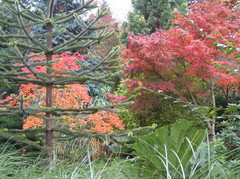
beaksterbart
9 years agoI they like damp soil but not soggy in my experience , I live in the north east of England and has planted this three times with only one doing well, and mine seems to do well in partial shade and damp soil, next to my pond, against a rockery
beaksterbart
9 years agoAnd for the comment that said they grow IN ponds, I have seen no evidence of this, and in my own experience the root rots when in constant water
beaksterbart
9 years agolast modified: 9 years agoI know that some plants can grow in both bog and marginal like brooklime , but gunnera doesn't seem to fit this definition
gardengal48 (PNW Z8/9)
8 years agoAs noted by a few previous posters, Gunnera do not require a bog to flourish. They will grow perfectly well in any good, rich garden soil if they receive adequate irrigation. Gunnera are extremely common in my area of the PNW and most are planted in just regular old garden soil, not in any sort of boggy situation. In this sort of situation, they will require summer watering - it tends to be very dry here in summer - but planting in a bog or alongside a pond is NOT a requirement. Some protection from the worst of the afternoon sun is suggested however, as the leaves can become crispy.
My nursery grows and sells a large quantity of gunnera each season and our huge display plant is in a large wooden box - no bog situation at all!!
Mike
8 years agolast modified: 8 years agoI have a friend who grows it on top of a mound of loam shaped like a rounded volcano in full sun. It's doing just fine, but requires adequate water to keep if from wilting.
Here's a picture of one of mine with a friend sticking her head up through a hole in a leaf that some unknown bug made. I can't imagine what that was. Maybe a hungry slug?
http://i75.photobucket.com/albums/i283/Botann/1096893354036511179.jpg
floral_uk z.8/9 SW UK
7 years agoAlthough spectacular, I'm wondering if people wanting to grow this plant realise that both leaves and stems are covered in sharp prickles. It isn't soft like rhubarb. Clearing the dead foliage away needs robust gloves. And it gets BIG. This one is growing in a Devon garden. Note the stems in the background - much taller than the person.

Mike McGarvey
7 years agoThe largest one I've seen growing was in North Devon. It was almost as large as a garage!
garyz8bpnw
7 years agolast modified: 7 years agoI LOVE the Dinosaur feel of these. Very tangible for me!

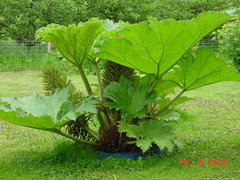
I live in PNW and have had them. They do tend to get droopy in the summer unless there is enough water supply here. You also need lots of space, such as a 12' area.
This is my latest solution for a new house near Seattle, with dry yard. The design is to be a dramatic backdrop behind the fishpond, as seen from the house. You walk between the pond and Gunnera so you can really see it and feel small. A 12' x 12' area was provided, and so in later mature years some pruning will still be needed to keep it in check
First G. tinctoria not G. manicata was selected. It is slightly smaller and perhaps more primal looking.
I dug a 8'x8'x4.5' deep pond, shown here partially dug. The pit was lined with heavy white plastic to make a pond bottom. The plastic stops at 12" from the surface, so near surface water can move and also keep it top flushed. This way there is always a 2.5' deeper Gunnera water sump. And the site acts much like the edge of a waterway having a less boggy top.
There are back exits to a plastic lined 2' deep Japanese Iris bog and nonlined Canna bog. This allows yard surface water to move towards the Gunnera, safety if the pit is overwatered and double the access of Gunnera to mobile ground water if we underestimate Gunnera water needs. The marked depth design is to encouage deep root growth, if we underwater overtime, the roots will adjust by growing deeper.

I used 50% Cedar Grove commercial municipal yard debris compost in all areas, except the top half of the main Gunnera pit, which has also has 20% peat moss.
We purchased a large overgrown Gunnera in one gallon plant in the spring and bumped it up to a 5 gallon tub site/light test this summer, on a large saucer of water. It loved the spot and here the 4-5' baby was planted. We have much clay in our soil and it took about a hour for the free surface water to drain in this hose soaking test.
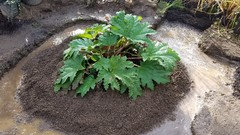
This photo shows the initial site. Parallax on the camera makes the pond look larger than it is. Pond is 15'. Gunnera space is 12'. So in a couple years this monster plant should look similar in size to the pond, and will be trying to not fall in the pond when walking by it.

Question: did I figure right or will it be too tight?
Mike McGarvey
7 years agoI don't know the Gunnera's ability to handle stagnant water. I know it can handle moving water no problem.
garyz8bpnw
7 years agolast modified: 7 years agoYes, thx river and spring areas arevsafest for water quality. But Gunnera are not that fussy. I've seen many Gunnera doing quite well around ponds in our wet (= rain flushing) PNW area.
I've also grown G. tinctoria in the ground in average soil with no bog. But even here in our moist environment during the summer the huge leaves on my 8-9' teenage plant would lower each afternoon towards the ground. A the plant looked water stressed each summer afternoon in a partial shade location. A larger 11 to 12' plant would thus edge burn before I got home from work to water!
When we kayak Lake Washington the Gunnera growing there (mostly G. manicata), in yards boardering the water, keep their leaf turgor and have no leaf edge burn. Landlocked and wanting that effect more secure I decided that the next one I grew it would have a kiddy pool or other significant backup water source buried under it.
Our is Gunnera bog pit ground water is not connected to the slow rain flushing fish pond. Our bog pit more rapidly drains surface and near subsurface water that a pond. The top 1' (20%) flushes because is only lined below. I did the perc test to make sure. Also a second 2' x 2' deep soil connected water outlet is to Canna / Hedychium side to help ensure that the surface ground water drains over time.
The point of the test is to determine best hydrology balance and give simple low effort hydrology control if needed to balance it. If the bog pit proves too wet over the summer I will dig on down hill side to lower the burried liner there. If it needs different adjustment in wet versus dry seasons a gate divider can be slid into place there (eg 2' x 1' board). The attached Japanese Iris bog is similarily being tested and adjusted this year The Iris are about 12" tall now.
Gunnera growth is in action now. It started with green Gunnera "leaf hands" reaching for the sun rays. When a volcano like mound of leaf mulch lifted upwards a couple feet I removed the leaves and saw them. Gotta love this monster species for drama alone!
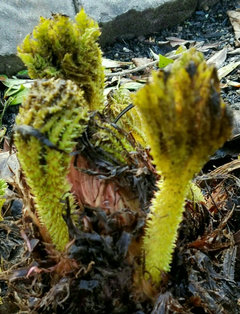
Below is the newly planted Japanese Iris Bog just before ground freeze late last fall. It connects to the Gunnera hydrology plan. The moist Iris zone is ~2.5' deep and average 3'+ wide. The tench shaped bog was again lined in bottom 1.5' with a pool like plastic liner. The bog has 50% compost. the Hydrangea paniculata 'Fire & Ice' root pit above to the left of the Iris is not lined.
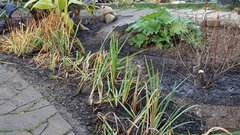
Some of the Siberian and Japanese Iris planted here are shown below (bed order is taller Siberian Iris nearer the Canna).
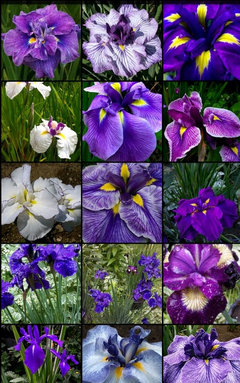
The colors contrast with our warm color Cannas, which are up to 8' tall. These are some of the varieties both in that bog area and seen behind them in beds running along the sides and back of the 15' long fish pond.

Our most stunning canna is perhaps Tropicanna = Durban = Phason.
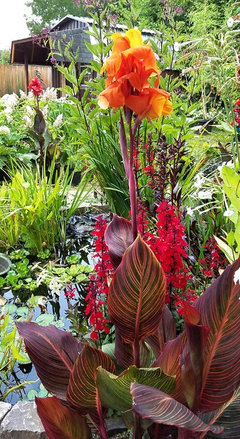
The tallest a German? hybrid variegated leaf Canna 'Stuttgart'.

Canna 'Cleopatra' a Chimera plant living together in leaves and flowers with it's miracle mutant partner is shorter than the Arian giant, is also pretty hard to ignore.

Hosting some valuable plant collection favorires, there's understandably some careful hydrology design to this test area. The Iris Bog liner does not connect pooled bottom water directly to the Canna / Hedychium area. The subsurface water drops into the deeper Gunnera Pit. If the average moisture balance is too dry in any area I can dig the edges down 12" and add an edge liner runner.
The overall test starts as best guess, but is easily adjustible. If is stays too wet and goes too stagnant a hole(s) can be punched into the bottom (slowly adding them) as needed. If the Canna / Hedychium area stays too wet, I can seperate it from the Gunnera as much ad needed by digging in a slotted liner or adding in a season adjustable gate.
As the moist Canna / Hedychium test zone hydrology is adjusted then proves out, I can accordingly lower the plant density and use excess plants to populate new 2nd generation moisture beds.
That's the plan anyway.
(My professional background is science research with microbes, plants and environmentally related tops. I love doing fun home tests like this! When a test "fails" one quickly gain solution ideas. And it can often be adjusted to soon prove out. If not adjust the plants varieties or specices tested.)
Our front yard is white different. The photo below show it currently during Spring warm up phase. The Red Crown Imperial Fritillaria near the turn in the walkway are not open yet. But their skunky scent contrasts the ~115 Hyacinths, 1/3 of which are open here already. The right central photo drift of Daffodils are Mt Hood currently doing their amazing magic trick of morphing from a smaller yellow/white flower (foreground) into to large full creamy white (background). These were planted at different times last fall and will synchronize by next year.

It shifts visually in late Spring-Summer-Fall to a hydrangea floral backdrop with perennial Liatris and Japanese Wildflower upper bed meadow like runners. They are in light pink and white tones to add a moongarden night element. And they actively sway with breezes adding motion to the sound of two timber bamboo behind them added for movement and sound effects (we get a lot of breeze activity through here).


And yellow dwarf fragrant Daylily and red Crocosmia flairs along the driveway to drive our visitors, family and hummingbirds wild.
Our main design theme is actually NO LAWN GRASS cutting and be glad for it visually. Was easy to tak my wife into it. I do all the msin design and garden work. She cuts the grass.
Mike McGarvey
7 years agoI like the fact you can adjust so you can find the best. Sort of like focusing a lens. My garden is also a learning device rather than an implemented preconceived plan. Learning is one of the great joys in gardening. Good post, BTW. :-)
garyz8bpnw
7 years agoOne year ago early in 2016 our back yard looked like this. Thankful for great starting yard structure to move into! First re- roofed, pianted and guttered it. Then dug fish pond.

Below are shown 2016 midsummer views before the Canna around the pond margins come into bloom and looking over the top of the Hydrangea 'Fire & Ice' before it shifts pink then red.

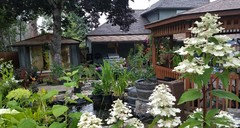
A design goal is inspire and uplift spirit walking around or just basking in the yard. Paver pathways give foot access to view and enjoy flower fragrances.
I work in a lot of white and noctural fragrance plants onto the design zones so that a moongarden effect baits us into the yard often and indoor TV in nice weather doesn't own your soul indoors.
Brugmansia fragrances are among the most alluring that I use for this. A 8" long 1" diameter cutting grows to 4-5'+ by fall. We've grown the compact std huge flowered 'Little Angel' from cuttings or in house or garage frost free stored plants years. I pit them where we want amazing fragrance, especially house entrance and late spring, summer and fall hammock area.
Brugmansia most commonly flower in flushes. Growing more than one kind can give you a least one in bloom at all times from mid summer here until frost. And it provides some variety in flower color, shape and complex fragrance element balance.

And 12" tall flowers astound the viewing effect any time you see them. At night the neighbors can also likely smell them too. (Just hope they become incensed in the right way.)
The light colors of 'Little Angel' and 'Maya = Sunset' give the most night vision Moongarden effect.

'Maya' also adds white highlights on the leaves. And in warmer weather some peach tones into the aging flowers.

Tall growing 'Naughty Nick' adds some dual skirt drama and scent.
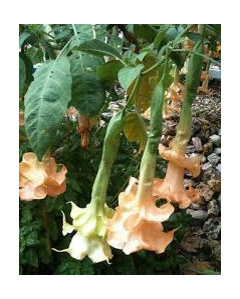
'Painted Lady' is quite alluring in shape and fragrance.

'Super Spot' is our most red colored Brugmansia.

And 'Samadhi' adds real visual day intrique and extra night fragrance.
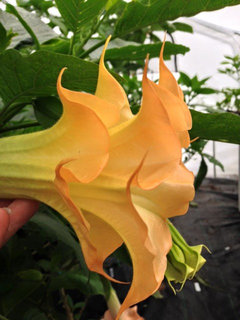
For sound effect we have many timber bamboo stands (larger pits with root barrier liners). And are hoping to attract local frogs to the new pond areas including a Lotus (non fish) side pond for polywog rearing and main larger fish pond 15' x 8.5' x 3'. We hear them near us, but our historically dry empty yard did not attract them into our yard in the past.
As new Grandparents we plan hosting a lot of family events. And we take a lot of flowers in to brighten work.
garyz8bpnw
7 years agolast modified: 7 years agoMike thx. Yes used to doing a "research for success" approach in former work jobs. And I hate killing great plants or waiting years to get it right. My past work fields required parallel testing in real time to solve things quite quickly.
In the yard tests, I observe daily and try to build in "modifiable as you learn" method adjustability to optimize as I go. Not always lucky the first time, but usually can get to a workable method PDQ.
I think most gardeners are doing this already more than they realize anyway. In watering frequency if nothing else.
With smartphones in hand about everywhere there's little excuse for not researching for success before you mistep. It greatly reduces need to test and reminds when you forget.
I Houzz post to help others as I gave been helped too. AND I'm often gifted great insights from others when I get it wrong or make wrong assumptions. Trick is to listen and learn quickly from our misteps and appreciate the wisdom of others. When something works or not, there is always a reason and key predictive principle for the future afoot.
_________<
Some folks reading this may not know Gunnera very well. It's an impressive, even humbling plant. Internet photo.
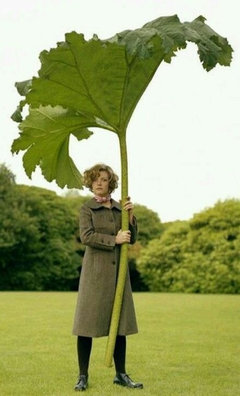
This photo and the thought that Dinosaurs probably ate this species at water's edge helps gift my preferred perspective. Imagine a Brontosaur swooping down to pluck the gift treat from her hands.
In fact, the peeled stems of this Gunnera tinctoria are an edible vegetable eaten by people in Chile from where it comes. Nice way to help contain a potentially invasive plant ... eat it.
But collect this Gunnera in the wild and know that earilier an Allosaur or T Rex probably harvested some of the animals eating it there too. They're all extinct now ... right? ... would you totally feel that way collecting there after dark? Have Jaguar taken over that terror-tory? And hiding under that leaf may not protect you quite enough?
keys6505
5 years agolast modified: 5 years ago
Hi Gary, I know this is an old post but was curious as to how the Gunnera experiment turned out. Im entering into summer #4 with my gunnera with little success getting any size out of it. Just looking for any advice you could offer. Thanks




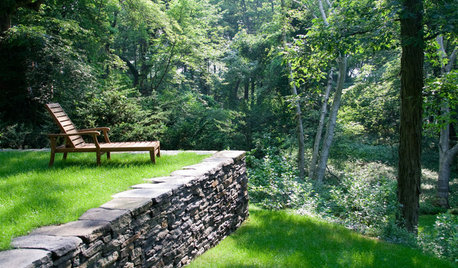

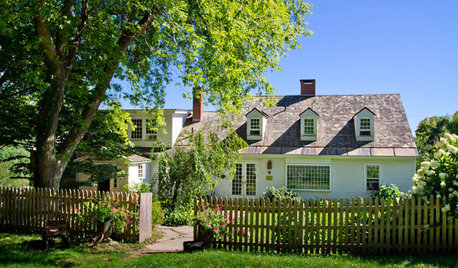
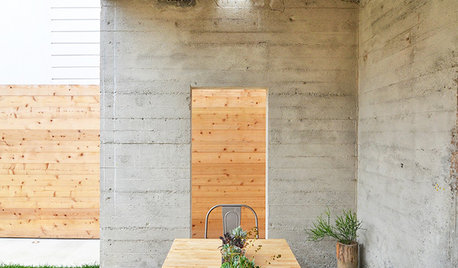








webfeeet